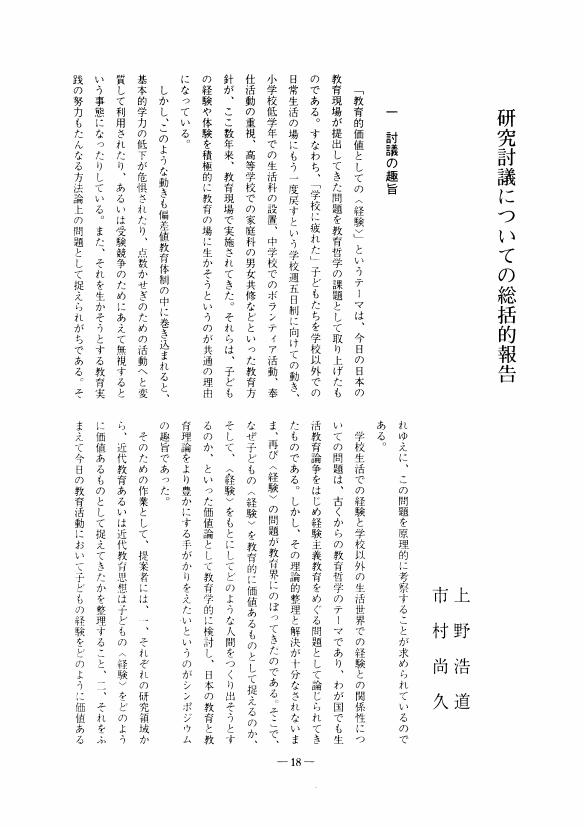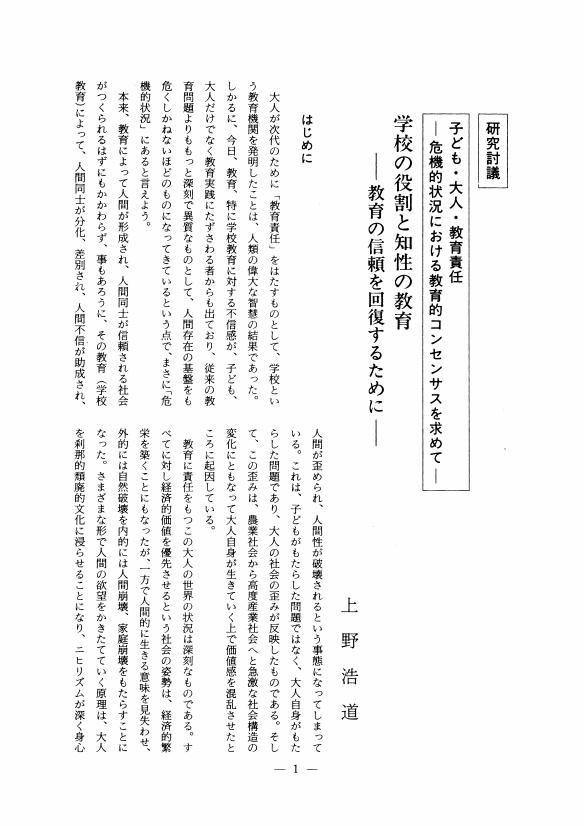1 0 0 0 OA 和田修二『教育する勇気』
- 著者
- 上野 浩道
- 出版者
- 教育哲学会
- 雑誌
- 教育哲学研究 (ISSN:03873153)
- 巻号頁・発行日
- vol.1995, no.71, pp.119, 1995-05-10 (Released:2009-09-04)
1 0 0 0 OA 研究討議についての総括的報告
- 著者
- 上野 浩道 市村 尚久
- 出版者
- 教育哲学会
- 雑誌
- 教育哲学研究 (ISSN:03873153)
- 巻号頁・発行日
- vol.1995, no.71, pp.18-22, 1995-05-10 (Released:2009-09-04)
1 0 0 0 OA 市村尚久著『エマソンとその時代』
- 著者
- 上野 浩道
- 出版者
- 教育哲学会
- 雑誌
- 教育哲学研究 (ISSN:03873153)
- 巻号頁・発行日
- vol.1994, no.70, pp.64-65, 1994-11-10 (Released:2009-09-04)
- 著者
- 上野 浩道
- 出版者
- 教育哲学会
- 雑誌
- 教育哲学研究 (ISSN:03873153)
- 巻号頁・発行日
- vol.1990, no.61, pp.1-6, 1990-05-10 (Released:2009-09-04)
- 参考文献数
- 4
1 0 0 0 OA アメリカにおけるart educationの動向
- 著者
- 上野 浩道
- 出版者
- 教育哲学会
- 雑誌
- 教育哲学研究 (ISSN:03873153)
- 巻号頁・発行日
- vol.1986, no.53, pp.100-105, 1986-05-10 (Released:2009-09-04)
1 0 0 0 OA 学校教育と美意識の形成 西洋画教育受容の一形態
- 著者
- 上野 浩道
- 出版者
- 教育哲学会
- 雑誌
- 教育哲学研究 (ISSN:03873153)
- 巻号頁・発行日
- vol.1979, no.40, pp.16-31, 1979-11-30 (Released:2009-09-04)
- 参考文献数
- 22
It is a characteristic of art in Japan that there are two styles of painting, Japanese and Western. In nurturing their sense of beauty, Japanese have been influenced both by their indigenous artistic culture and by the expression and way of pursuing beauty on the part of foreign arts. This is particularly true in public art education in Japan, which imported a great many ideas of western painting to enrich the Japanese way of thinking and expression.The purpose of this paper is to clarify how the ideas of western painting influenced the viewpoint and expression of N. Inamori (1892-1978), who was an ordinary school teacher, that is; a typical Japanese.N. Inamori, who was brought up in the Japanese culture, nurtured his sense of beauty within its confines. Then, in school, he received ringa (conventional training in copying pictures in the textbook), jiyuga (style of painting free from textbook restraints) education and studied Western viewpoint and expression. However, he could not understand scientific and analytical perception and expression. Later, retiring from teaching, he did Japanese painting and calligraphy as his hobby.By pursuing the process of nurturing his sense of beauty and analyzing his paintings, the following three points were clarified. (1) The technique of line drawings by ringa influenced the form of his expression for a long time. While, jiyuga education made him perceive and portray the essense of nature and life directly. It put stress on children's individual freedom, inner expression and their subjective activity. (2) Education in Western painting taught him the importance of observing objects attentively and rationally ; scientifically, analytically and mathematically. Technically, it taught himthe lams of perspective and shading, so on. But, he could not understand the Western thought behind the techniques, especially the thought that aimed at the perfected ego and the development of science. (3) He could not perceive and paint nature objectively and concretely as a third party. Because, he does not perceive the world in opposition to ego, but he finds his self in the world. The emotion, viewpoint, and expression that he had experienced in his early days was his basic and fundamental way of perception, expression and sense of beauty.
1 0 0 0 OA 大正期芸術教育運動の研究 (1) : 山本鼎の自由画教育運動について
- 著者
- 上野 浩道
- 出版者
- 一般社団法人 日本教育学会
- 雑誌
- 日本教育学会大會研究発表要項 (ISSN:2433071X)
- 巻号頁・発行日
- vol.29, pp.15, 1970-08-26 (Released:2018-04-20)
1 0 0 0 OA 明治期の芸術教育
- 著者
- 上野 浩道
- 出版者
- 舞踊学会
- 雑誌
- 舞踊學 (ISSN:09114017)
- 巻号頁・発行日
- vol.1999, no.1Supplement, pp.38-40, 1999 (Released:2010-04-30)
1 0 0 0 IR 日・台美術教育研究会議について
- 著者
- 上野 浩道
- 出版者
- 日本教育学会
- 雑誌
- 教育學研究 (ISSN:03873161)
- 巻号頁・発行日
- vol.65, no.2, pp.174-175, 1998-06-30
- 著者
- 上野 浩道
- 出版者
- 一般社団法人 日本教育学会
- 雑誌
- 日本教育学会大會研究発表要項
- 巻号頁・発行日
- vol.29, 1970






